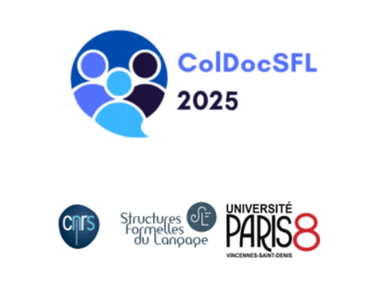Call for Papers > Call for PapersIn linguistics, the notion of interface allows us to understand the interactions between the different levels of linguistic analysis and their interdisciplinary implications. We define interfaces as the links, connections, and/or joints functioning of several In formal linguistics, this interface is often understood as the junction of the different layers of linguistic analysis and their logical relationships (Chomsky, 2001), thus highlighting the complexity of human language in their L1 or LN (Ramchand and Reiss, 2007; Ackerman and Malouf, 2013, Domínguez, 2013).These various interfaces enable in-depth analysis of language, linking syntax and semantics (Wechsler, 2020; Woods, 2020), morphology and syntax (Cocchi and Pierrantozzi, 2022) and phonology and morphology (Zukoff, 2023; Kalin, 2022), etc. These interfaces sometimes raise questions in cases of inter-language comparison, raising the problem of the scope of these interfaces (Cuxac, 2000; Tuggy, 2010). In applied linguistics, this interface is understood as the link between two concepts, one strictly linguistic and one extralinguistic. These interfaces manifest themselves in the interpretation of linguistic phenomena in connection with cognition (Chomsky, Submission modalities:Please include the affiliations of the authors on the submission. The first author and main presenter at the ColDoc must be a PhD student or a young researcher. Please indicate if your proposal is for at the oral/signed format, or a poster. In order to submit, please use this website, at the "abstract submission" page.
Information on the abstract format: - Languages: French and English - Please indicate the language of the proposal (French, French Sign Language or English) - Max: 500 words including a short bibliography Bibliography:Ackerman, F., & Malouf, R. (2013). Morphological Organization : The Low Conditional Entropy Conjecture. Language, 89 (3), 429‑464. Avanzi, M., & Thibault, A. (forthcoming). Le français du Saguenay-Lac-Saint-Jean : Essai de caractérisation dialectologique sur la base d’enquêtes en ligne. In L. Baronian & S. Tailleur (Eds.), Actes de la 8e édition du colloque : Les français d’ici. Blondel, M. (2020). Les langues des signes, des langues incarnées [Habilitation à diriger des recherches]. Bourdieu, P. (2012). Ce que parler veut dire : L’économie des échanges linguistiques. Fayard. Boyer, H. (1991). Langues en conflit : Études sociolinguistiques. L’Harmattan. Calvet, L.-J. (1998). La sociolinguistique (3rd ed.). Presses Universitaires de France. Catach, N. (1988). Fonctionnement Linguistique et Apprentissage de la Lecture. Langue Française, 80, 6‑19. Chomsky, N. (2001). The minimalist program (4th ed.). MIT Press. Chomsky, N. (2006). Language and Mind (3rd ed.). Cambridge University Press. Chomsky, N., & Halle, M. (1973). Principes de Phonologie Générative (P. Encrevé, Trad.; Editions du Seuil). Cocchi, G., & Pierantozzi, C. (2022). Mixed Compounds: Where Morphology Interfaces with Syntax. Languages, 7 (3), 230. Cook, V. (Ed.). (2004). Portraits of the L2 user. Multilingual Matters. Cuxac, C. (2000). La langue des signes Française (LSF) : Les voies de l’iconicité. Ophrys. Domínguez, J. (2014). Understanding Interfaces : Second Language Acquisition And First Language Attrition Of Spanish Subject Realization And Word Order Variation. Studies in Hispanic and Lusophone Linguistics, 7 (2), 397‑406. Estève, I., & Millet, A. (2009). Contacts de Langues et Multimodalité chez des locuteurs sourds : Concepts et outils méthodologiques pour l’analyse. Journal of Language Contact, 2 (2), 111‑131. Fornasiero, E., Hauser, C., & Branchini, C. (2024). The subject advantage in LIS internally headed relative clauses : An eye-tracking study. In Abutalebi , J. & Clahsen, H. (Eds), Bilingualism: Language and Cognition (p.1‑14). Cambridge Garcia, B. (2010). Sourds, surdité, langue(s) des signes et épistémologie des sciences du langage. Problématiques de la scripturisation et modélisation des bas niveaux en Langue des Signes Française. [PhD dissertation] Geeraerts, D. & Cuyckens, H. (Ed.). (2010). The Oxford handbook of cognitive linguistics. Oxford University Press. Halliday, M. A. K. (1990). Spoken and written language (2nd ed.). Oxford University Press. Harris, R. (1985). Signs of Writing. Routledge. Hornberger, N. H. (2006). Discursive Approaches to Understanding Teacher Collaboration: Policy into Practice. International Journal of Bilingual Education and Bilingualism, 9 (4), 495‑499. Kalin, L. (2023). When size matters in infix allomorphy : A unique window into the morphology-phonology interface. In Z. Shen & S. Laszakovits (Eds.), The size of things II: movement, features, and interpretation (p. 269‑296). Language Science Press. Klein, W., & Perdue, C. (1997). The Basic Variety (or : Couldn’t natural languages be much simpler?). Second Language Research, 13 (4), 301‑347. Kress, G. R., & van Leeuwen, T. (2001). Multimodal discourse: The modes and media of contemporary communication. Arnold. Levelt, W. J. M. (1981). The speaker’s linearization problem. Philosophical Transactions of the Royal Society of London. B, Biological Sciences, 295 (1077), 305‑315. Levelt, W. J. M. (1989). Speaking : From intention to articulation. MIT press. Portes, C., & German, J. S. (2019). Implicit effects of regional cues on the interpretation of intonation by Corsican French listeners. Laboratory Phonology: Journal of the Association for Laboratory Phonology, 10 (1), 22. Ramchand, G., & Reiss, C. (2007). The Oxford handbook of linguistic interfaces. Oxford University Press. Sutton-Spence, R., & Machado, F. D. A. (2023). Creative Sign Language (1st ed.) . Cambridge University Press. Tibblin, J., Granfeldt, J., Van De Weijer, J., & Gygax, P. (2023). The male bias can be attenuated in reading : On the resolution of anaphoric expressions following gender-fair forms in French. Glossa Psycholinguistics, 2 (1). Tuggy, D. (2010). Schematicity. In Geeraerts, D. & Cuyckens, H. (Ed.), The Oxford handbook of cognitive linguistics. Oxford University Press. Wechsler, S. (2020). The Role of the Lexicon in the Syntax–Semantics Interface. Annual Review of Linguistics, 6 (1), 67‑87. Woods, R. (2021). Towards a model of the syntax–discourse interface: A syntactic analysis of please. English Language and Linguistics, 25 (1), 121‑153. Zukoff, S. (2023). The Mirror Alignment Principle : Morpheme ordering at the morphosyntax-phonology interface. Natural Language & Linguistic Theory, 41 (1), 399‑458. |


